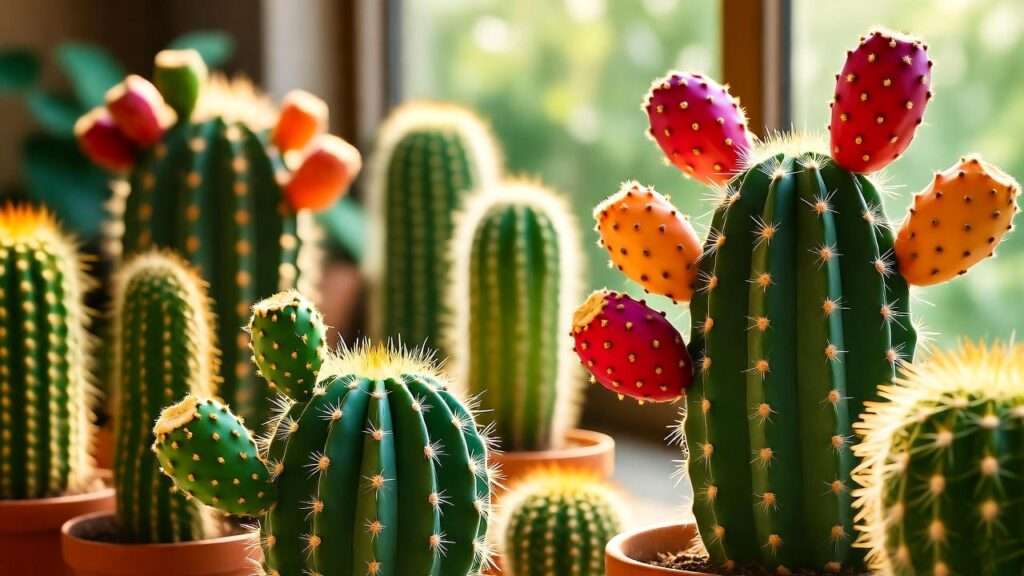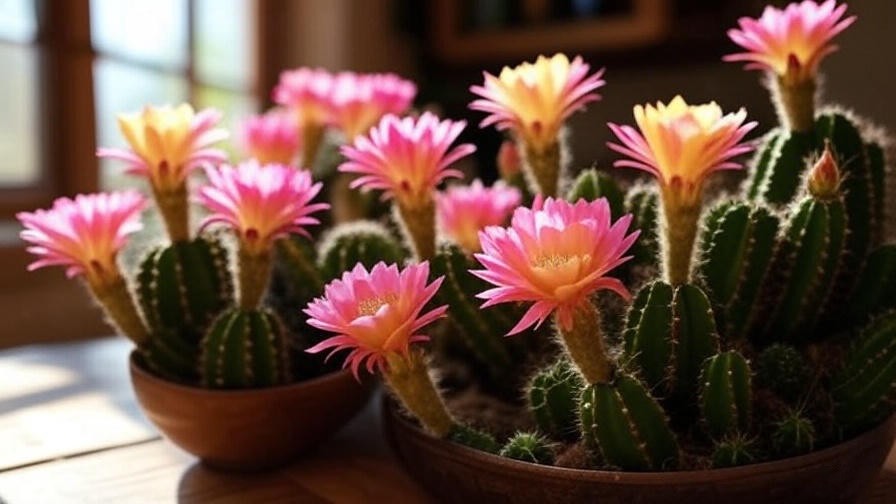Imagine biting into a sweet, tangy treat that captures the essence of your favorite indoor cactus, transforming its prickly charm into a delightful confection. Cactus candy, made from the vibrant fruit of plants like the prickly pear, is the perfect way to blend your love for indoor plants with culinary creativity. For plant enthusiasts, this unique dessert offers a sustainable, fun way to celebrate cacti beyond their decorative appeal. In this article, we’ll share five irresistible cactus candy recipes, expert tips on sourcing ingredients, and insights into the cultural and botanical significance of cacti in candy-making. Drawing on advice from botanists and home gardeners, we’ll guide you through crafting these delicious treats at home, ensuring every bite reflects your passion for indoor plants.
What Is Cactus Candy? A Sweet Spin on Your Favorite Indoor Plants
The Origins of Cactus Candy

Cactus candy has deep roots in the culinary traditions of the Southwestern United States and Mexico, where cacti like the prickly pear (Opuntia species) thrive. Historically, Indigenous communities used the vibrant red or purple fruit, known as tunas, to create sweet preserves and confections. According to Dr. Maria Lopez, a botanist specializing in desert plants, “Prickly pear fruit was a staple in arid regions, valued for its nutrition and versatility.” By the 19th century, settlers in Arizona and New Mexico began commercializing cactus candy, turning it into a regional delicacy. Today, it’s a nostalgic treat that’s gaining renewed interest among indoor plant enthusiasts who want to explore their cacti in new ways.
Why Make Cactus Candy at Home?
Making cactus candy at home is more than a culinary adventure—it’s a celebration of sustainability and creativity. The prickly pear fruit is packed with antioxidants, vitamin C, and fiber, offering a healthier alternative to traditional candies when prepared thoughtfully. For indoor plant lovers, it’s a chance to repurpose parts of their cacti, reducing waste while creating something delicious. As home gardener Sarah Thompson shares, “Turning my prickly pear harvest into candy feels like giving my plants a second life.” Plus, the process is fun, customizable, and perfect for sharing with fellow plant enthusiasts.
How Cactus Candy Fits Into Indoor Plant Culture
The indoor plant community thrives on creativity, from propagating succulents to crafting plant-inspired decor. Cactus candy fits perfectly into this culture, bridging the gap between gardening and gastronomy. It’s a way to honor your cacti’s beauty and utility, transforming their fruit into a conversation starter. Whether you’re hosting a plant-themed party or gifting homemade treats, cactus candy elevates your indoor plant passion into a multisensory experience.
Choosing the Right Cactus Ingredients for Candy-Making
Best Cactus Varieties for Candy
Not all cacti are edible, but the prickly pear is the star of cactus candy. Its fruit, or tunas, offers a sweet-tart flavor reminiscent of watermelon or kiwi. The pads (nopales) can also be used for a more earthy taste. Another option is dragon fruit from the Hylocereus cactus, which adds a milder, tropical note. Below is a comparison of cactus varieties suitable for candy-making:
| Cactus Type | Flavor Profile | Availability |
|---|---|---|
| Prickly Pear Fruit | Sweet-tart, juicy | Local markets, home-grown |
| Prickly Pear Pads | Earthy, mild | Specialty grocers |
| Dragon Fruit | Sweet, subtle | Supermarkets, online |
Sourcing Cactus Ingredients Safely
Finding prickly pear fruit or pads is easier than you might think. Local farmers’ markets, especially in the Southwest, often carry fresh tunas. Online retailers like Desert Farms or specialty stores offer dried or juiced options. If you grow prickly pear indoors, ensure the fruit is ripe (deep red or purple) before harvesting. Safety Tip: Use gloves and tongs to handle fruit to avoid spines, and always verify the cactus is edible. Non-edible varieties, like the barrel cactus, can be toxic.
Sustainable Harvesting for Indoor Plant Owners
Growing prickly pear indoors is a rewarding way to source your own candy ingredients. These hardy cacti thrive in bright light and require minimal water, making them ideal for small spaces. To harvest sustainably, snip ripe fruit or pads carefully, leaving enough for the plant to regenerate. “Only take what you need,” advises horticulturist James Carter. “A healthy prickly pear can produce fruit for years with proper care.” Check out our guide on indoor cactus care for tips on cultivating your own edible cacti.
5 Irresistible Cactus Candy Recipes for Every Skill Level
Recipe 1: Classic Prickly Pear Cactus Candy
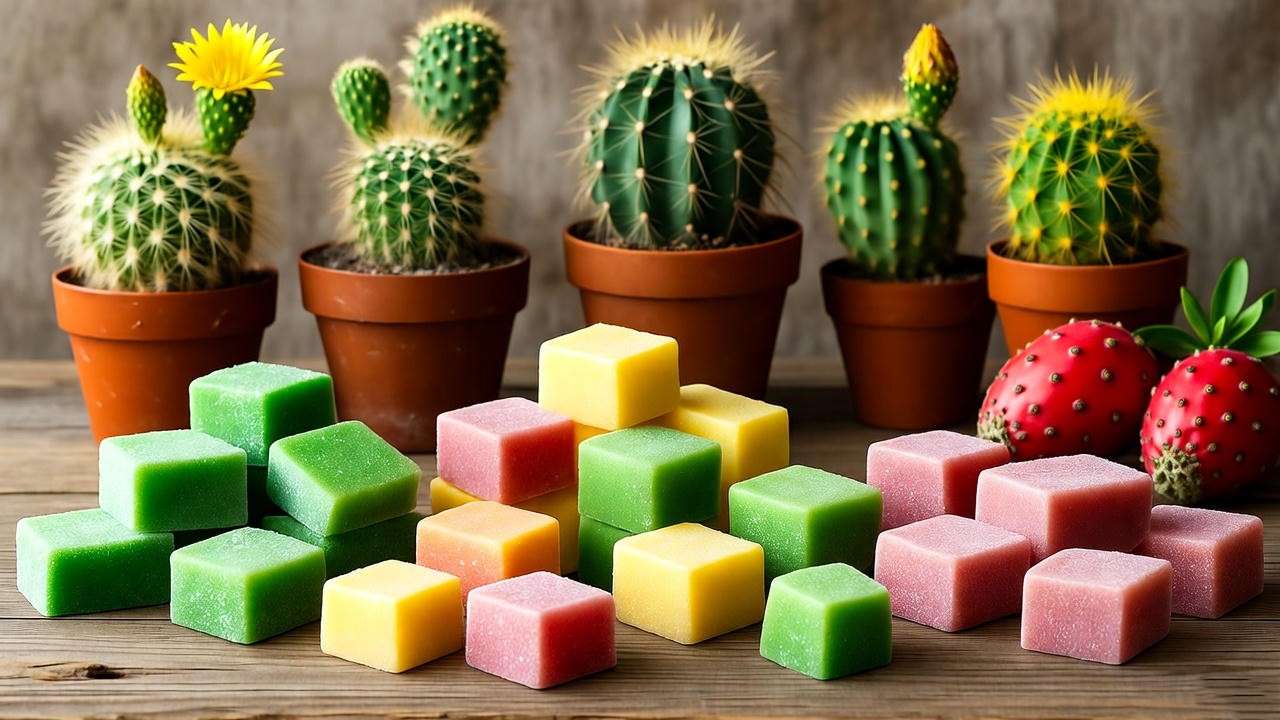
Ingredients (Makes ~20 pieces):
- 2 cups prickly pear juice (from ~10 ripe fruits)
- 2 cups granulated sugar
- 1 tbsp lemon juice
- 1 packet (1 oz) pectin
- Powdered sugar for dusting
Instructions:
- Peel and blend prickly pear fruit, straining to remove seeds and extract juice.
- In a saucepan, combine juice, sugar, and lemon juice. Bring to a boil over medium heat.
- Stir in pectin and boil for 10–12 minutes, stirring constantly until thickened.
- Pour into a greased 8×8-inch pan and let set for 4 hours.
- Cut into squares, dust with powdered sugar, and store in an airtight container.
Pro Tip: For a softer texture, reduce boiling time by 2 minutes, says chef Maria Gonzalez.
Recipe 2: Spiced Cactus Candy Bites
Ingredients (Makes ~25 bites):
- 1.5 cups prickly pear juice
- 1.5 cups sugar
- 1 tsp chili powder
- 1 tsp cinnamon
- 1 tbsp lime juice
- 1 packet pectin
Instructions:
- Follow the same juicing process as above.
- Combine juice, sugar, chili powder, cinnamon, and lime juice in a saucepan.
- Boil for 8–10 minutes, add pectin, and cook for another 2 minutes.
- Pour into silicone molds for bite-sized shapes and let set for 3 hours.
- Dust with a chili-sugar mix for extra flair.
Pairing Suggestion: Serve with iced tea for a refreshing contrast.
Recipe 3: Vegan Cactus Fruit Jellies
Ingredients (Makes ~15 jellies):
- 2 cups prickly pear juice
- 1 cup agave nectar
- 2 tbsp agar-agar powder
- 1 tbsp orange zest
Instructions:
- Blend and strain prickly pear fruit for juice.
- Heat juice and agave in a saucepan until warm (not boiling).
- Whisk in agar-agar and simmer for 5 minutes, stirring constantly.
- Add orange zest, pour into molds, and refrigerate for 2 hours.
- Pop out jellies and serve chilled.
Pro Tip: “Agar-agar sets quickly, so work fast,” advises vegan chef Emma Ruiz.
Recipe 4: Cactus Candy Truffles

Ingredients (Makes ~12 truffles):
- 1 cup prickly pear puree
- 8 oz dark chocolate (70% cocoa)
- 1/2 cup coconut milk
- Cocoa powder for coating
Instructions:
- Puree prickly pear fruit and strain to remove seeds.
- Melt chocolate with coconut milk in a double boiler.
- Stir in puree and chill mixture for 2 hours.
- Scoop into balls, roll in cocoa powder, and refrigerate for 1 hour.
Troubleshooting: If truffles are too soft, chill longer before rolling.
Recipe 5: Sugar-Free Cactus Candy Chews
Ingredients (Makes ~20 chews):
- 2 cups prickly pear juice
- 1/2 cup monk fruit sweetener
- 1 packet pectin
- 1 tbsp lemon extract
Instructions:
- Extract juice as described above.
- Combine juice, monk fruit, and lemon extract in a saucepan.
- Boil for 10 minutes, add pectin, and cook for 3 more minutes.
- Pour into a lined pan and let set for 4 hours.
- Cut into chews and store refrigerated.
Health Note: Monk fruit keeps these chews low-calorie without sacrificing sweetness.
Step-by-Step Guide to Perfect Cactus Candy
Essential Tools and Equipment
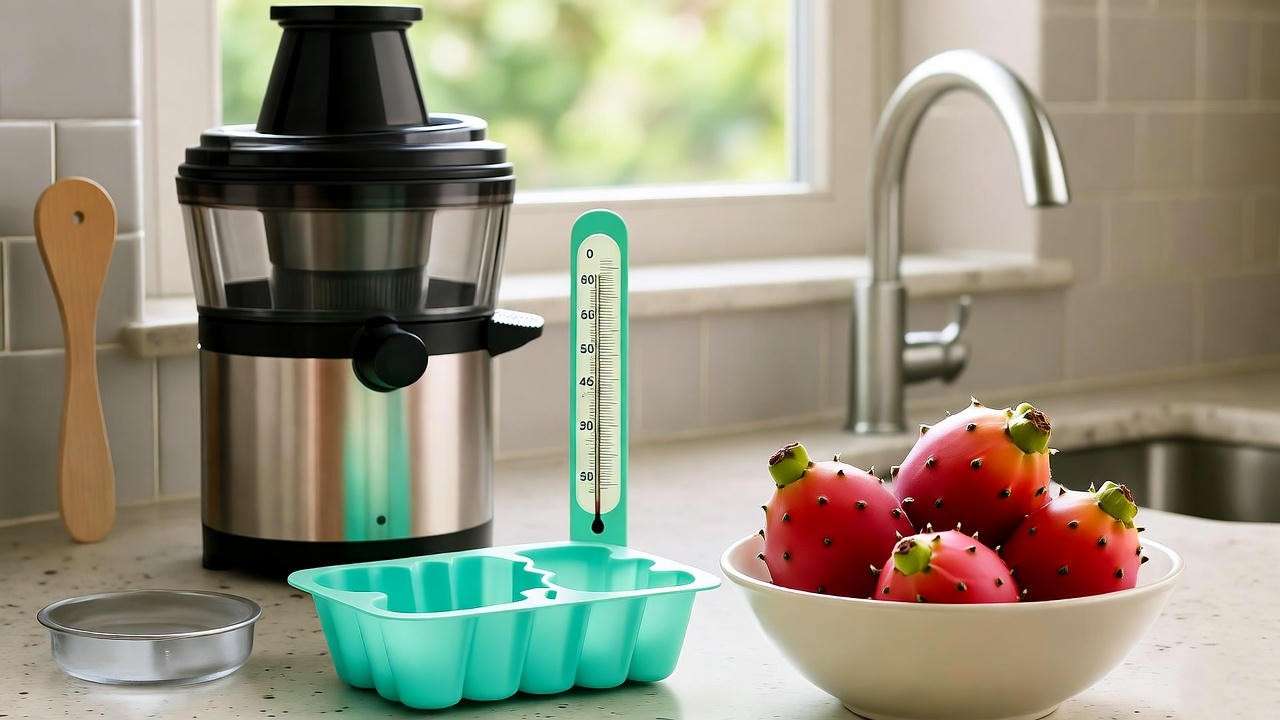
To make cactus candy, you’ll need:
- Juicer or blender: For extracting prickly pear juice.
- Candy thermometer: Ensures precise cooking temperatures.
- Silicone molds: For fun shapes (optional but beginner-friendly).
- Heavy-bottomed saucepan: Prevents burning during boiling.
- Affordable options are available at kitchen stores or online for under $20.
Preparing Cactus Ingredients

- Peeling: Wear gloves and use tongs to hold prickly pear fruit. Slice off ends and cut a shallow slit lengthwise to peel off skin.
- Juicing: Blend peeled fruit and strain through cheesecloth to remove seeds.
- Pads: If using nopales, boil pads for 10 minutes to reduce sliminess, then puree. Safety Tip: Always double-check that your cactus is edible to avoid toxicity.
Common Mistakes to Avoid
| Issue | Solution |
|---|---|
| Candy too sticky | Boil longer or add more pectin |
| Bitter taste | Use ripe fruit; avoid green tunas |
| Grainy texture | Stir constantly while boiling |
Storage and Shelf Life
Store cactus candy in airtight containers at room temperature for up to 2 weeks or refrigerate for 1 month. For gifting, wrap in parchment paper and include a “best by” date. Freezing is not recommended, as it alters texture.
The Science and Art of Cactus Candy-Making
Why Cactus Ingredients Work in Candy
The magic of cactus candy lies in the natural properties of prickly pear fruit. According to food scientist Dr. Elena Martinez, “Prickly pear fruit is rich in pectin, a natural gelling agent, and contains sugars that caramelize beautifully when cooked.” This makes it ideal for creating chewy, gummy-like textures without artificial additives. The fruit’s high water content and vibrant pigments also contribute to its appeal, producing candies with striking colors and a refreshing taste. These properties, combined with the fruit’s nutritional benefits like antioxidants and vitamin C, make cactus candy both delicious and wholesome.
Balancing Flavors for the Perfect Candy
Prickly pear’s sweet-tart profile pairs well with complementary flavors. Citrus notes, like lemon or lime, enhance its brightness, while warm spices like cinnamon or vanilla add depth. For a bold twist, try a pinch of chili powder, a nod to Southwestern cuisine. Below is a flavor profile chart to inspire your creations:
| Flavor Pairing | Effect | Example Recipe |
|---|---|---|
| Lemon/Lime | Brightens tartness | Classic Cactus Candy |
| Cinnamon/Chili | Adds warmth and spice | Spiced Cactus Bites |
| Vanilla | Softens acidity | Cactus Truffles |
Expert Tip: Taste your juice before cooking to adjust sweetness, as ripeness varies.
Customizing Your Cactus Candy
Get creative by adding edible flowers like hibiscus for a floral note or natural dyes like beet powder for vibrant hues. Fresh herbs, such as mint or rosemary, can elevate the flavor while tying into the plant theme. For a modern twist, experiment with shapes using silicone molds (e.g., cactus or star shapes) to delight indoor plant enthusiasts. Keep customizations simple to let the cactus shine, ensuring the candy remains true to its desert roots.
Cactus Candy in Indoor Plant Culture: Beyond the Kitchen
Hosting a Cactus Candy-Making Party
Turn your love for indoor plants into a memorable event by hosting a cactus candy-making party. Invite fellow plant enthusiasts to a hands-on workshop combining candy crafting with cactus care tips. Checklist:
- Supplies: Prickly pear fruit, sugar, molds, and recipe cards.
- Activities: Demonstrate juicing techniques, share a candy recipe, and offer a mini cactus-planting station.
- Ambiance: Decorate with succulents and desert-themed tableware. This event fosters community and celebrates the creativity of plant lovers. “My cactus candy party was a hit,” says indoor gardener Lily Chen. “Guests loved making treats and swapping plant care tips.”
Gifting Cactus Candy to Plant Lovers
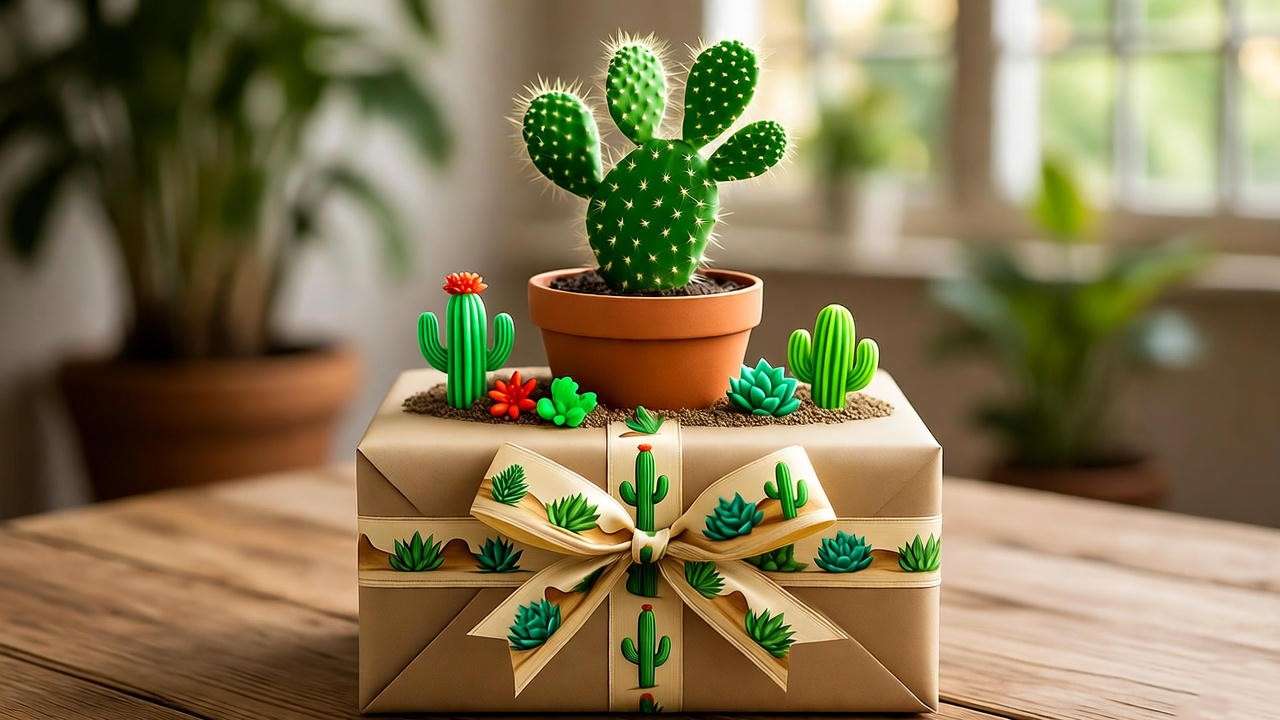
Cactus candy makes a thoughtful gift for plant enthusiasts. Package it in eco-friendly materials like glass jars or biodegradable wraps, and add a cactus-themed gift tag. Pair the candy with a small potted prickly pear or succulent for a unique gift set. Include a care guide to help recipients grow their own edible cacti, reinforcing sustainability. These gifts are perfect for holidays, birthdays, or plant swap events.
Sharing Your Creations Online
Showcase your cactus candy on social media to connect with the indoor plant community. Post high-quality photos of your candies alongside your cacti, using hashtags like #CactusCandy, #IndoorPlantLife, or #PlantBasedTreats. Share your process on Instagram Stories or create a Pinterest board with recipe ideas. Engage followers by asking, “What’s your favorite cactus candy flavor?” This boosts discoverability and builds your authority in the plant enthusiast niche.
Frequently Asked Questions (FAQs)
Is cactus candy safe to eat? Yes, cactus candy made from edible cacti like prickly pear is safe when prepared properly. Always use ripe fruit, handle with gloves to avoid spines, and verify the cactus species is non-toxic. Consult a botanist or reliable source if unsure.
Can I use store-bought prickly pear juice? Store-bought juice is a convenient alternative, but choose 100% pure juice without added sugars or preservatives. Check labels for quality, and avoid blends that dilute the prickly pear flavor.
How do I grow my own prickly pear for candy? Prickly pear cacti thrive indoors with bright light and minimal watering. Use well-draining soil and a pot with drainage holes. Harvest fruit when deep red or purple, typically in late summer. See our prickly pear care guide for details.
What if I don’t have access to fresh cactus fruit? Dried prickly pear or online suppliers like Desert Farms offer viable alternatives. Rehydrate dried fruit in warm water before juicing, or purchase pre-made prickly pear puree for convenience.
How long does homemade cactus candy last? Stored in airtight containers, cactus candy lasts up to 2 weeks at room temperature or 1 month refrigerated. Avoid freezing, as it can affect texture. Label gifts with a “best by” date for freshness.
Conclusion
Cactus candy is more than a sweet treat—it’s a celebration of your indoor plant passion, blending the beauty of cacti with culinary creativity. With these five irresistible recipes, you can transform prickly pear fruit into delicious confections that delight the senses and spark conversation. From classic gummies to vegan jellies and decadent truffles, there’s a recipe for every skill level. Experiment with flavors, share your creations with the plant community, and explore the sustainable joy of cactus candy. Ready to get started? Try one of our recipes, share your results in the comments, or check out our indoor cactus care tips to grow your own ingredients. Let’s sweeten the indoor plant world, one cactus candy at a time!

